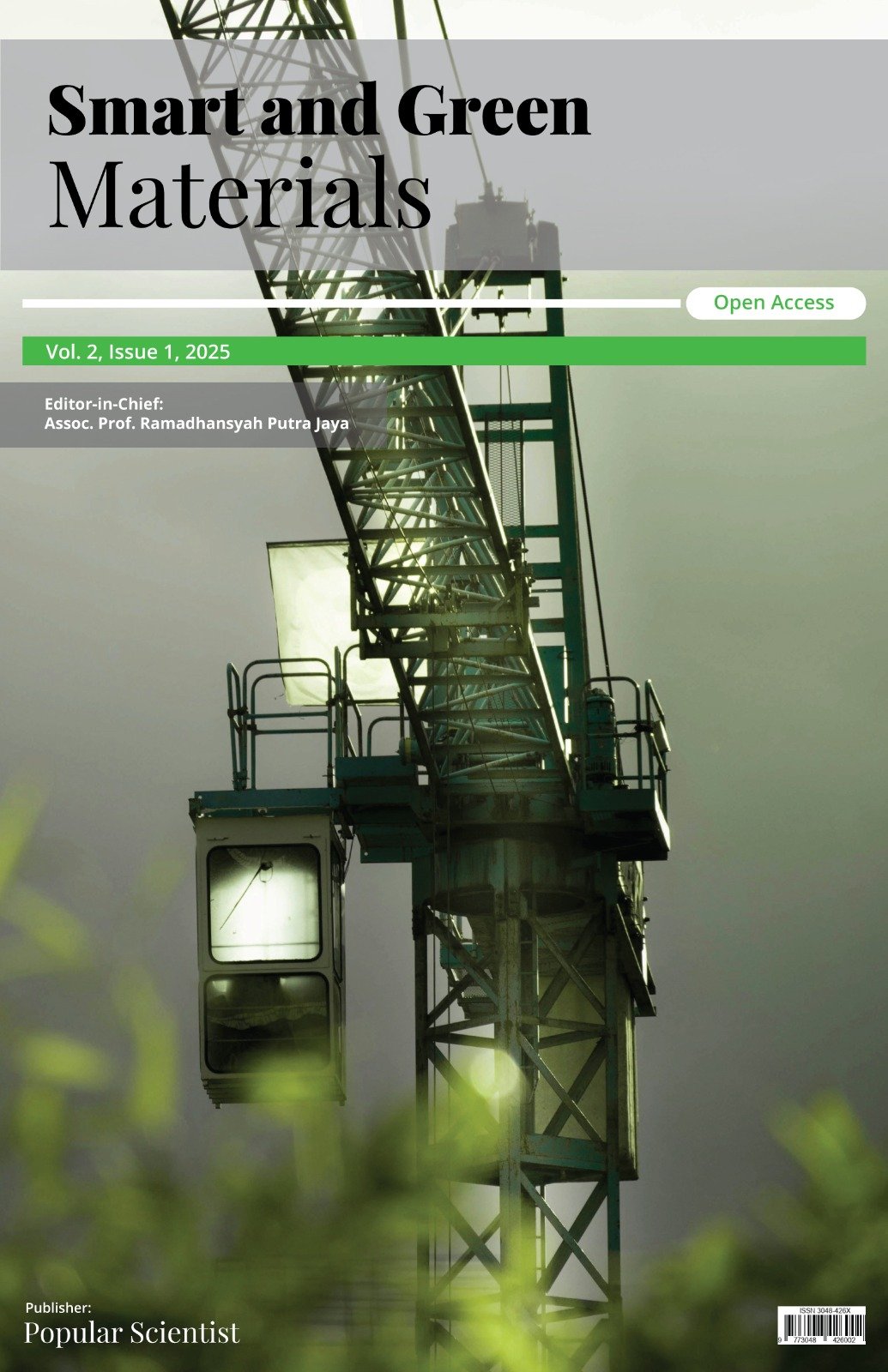Compressive Strength Behavior of Recycled Concrete with Fine Aggregate Replacement Using Rubber Crumb
DOI:
https://doi.org/10.70028/sgm.v2i1.36Keywords:
Recycled Aggregates, Rubberized Concrete, Compressive Strength, Rubber Crumb, Curing PeriodsAbstract
The use of recycled materials in concrete has drawn considerable attention in recent years as it means to enhance sustainability, strength, minimize landfill waste, cut carbon emissions and diminish the environmental influence of construction methods. This study focuses on investigating the compressive strength behaviour and sustainability analysis of rubberized concrete incorporating recycled aggregates. In this study, compressive strength tests have been conducted following standardized procedures to assess the load bearing capacity of rubberized concrete at different curing periods. The results will provide valuable information for engineers, researchers, and policymakers engaged in the development and utilization of sustainable construction practices. Recycle aggregates size ranging from 4.75 mm to 25 mm collected from crushing pile head from various construction site are utilized in this experimental research and also rubber crumbs are used as a partial substitute of fine aggregate at percentages of 6%,12%,18% and 25%, while maintaining a constant ratio of cement to water 0.45. The study was conducted at three different curing days of 7 days, 14 days and 28 days. From the test result, it has been noticed that conventional concrete has achieved the most effective result compared to the other percentages of mixtures of rubber crumb. Additionally, the compressive strength has been gradually decreased up to 56.82% in tandem with the increasing percentage of rubber crumb replacement in the specimens.
Downloads
References
S. U. Azunna, F. N. A. A. Aziz, R. S. M. Rashid, and N. B. A. Bakar, “Review on the characteristic properties of crumb rubber concrete,” Cleaner Mater., vol. 10, Art. no. 100237, Jun. 2024, doi: http://dx.doi.org/10.1016/j.clema.2024.100237
W. H. Beitelmal, S. C. Nwokolo, E. L. Meyer, and C. C. Ahia, “Exploring adaptation strategies to mitigate climate threats to transportation infrastructure in Nigeria: Lagos City, as a case study,” Climate, vol. 12, no. 8, Art. no. 117, Aug. 2024, doi: http://dx.doi.org/10.3390/cli12080117
O. Guerrero-Bustamante et al., “Implementation of crumb rubber (CR) in road pavements: A comprehensive literature review,” Infrastructures, vol. 9, no. 12, Art. no. 223, Dec. 2024, doi: http://dx.doi.org/10.3390/infrastructures9120223
M. Kioumarsi, Ed., The 1st International Conference on Net-Zero Built Environment. Available: https://books.google.com.bd/books?id=EUg9EQAAQBAJ.
P. Minde, M. Kulkarni, J. Patil, and A. Shelake, “Comprehensive review on the use of plastic waste in sustainable concrete construction,” Discover Sustain., vol. 5, Art. no. 31, Dec. 2024, doi: http://dx.doi.org/10.1007/s43939-024-00126-1
M. Bravo and J. De Brito, “Concrete made with used tyre aggregate: Durability-related performance,” J. Clean. Prod., vol. 25, pp. 42–50, Apr. 2012, doi: http://dx.doi.org/10.1016/j.jclepro.2011.11.066
E. Eltayeb, X. Ma, Y. Zhuge, J. Xiao, and O. Youssf, “Dynamic performance of rubberised concrete and its structural applications – An overview,” Eng. Struct., vol. 237, Art. no. 111990, May 2021, doi: http://dx.doi.org/10.1016/j.engstruct.2021.111990
R. Roychand, R. J. Gravina, Y. Zhuge, X. Ma, O. Youssf, and J. E. Mills, “A comprehensive review on the mechanical properties of waste tire rubber concrete,” Constr. Build. Mater., vol. 237, Art. no. 117651, Mar. 2020, doi: http://dx.doi.org/10.1016/j.conbuildmat.2019.117651
M. D. Kaplowitz, F. K. Yeboah, L. Thorp, and A. M. Wilson, “Garnering input for recycling communication strategies at a Big Ten university,” Resour. Conserv. Recycl., vol. 53, no. 11, pp. 612–623, Sep. 2009, doi: http://dx.doi.org/10.1016/j.resconrec.2009.04.018
J. Wang and B. Du, “Experimental studies of thermal and acoustic properties of recycled aggregate crumb rubber concrete,” J. Build. Eng., vol. 32, Art. no. 101836, Nov. 2020, doi: http://dx.doi.org/10.1016/j.jobe.2020.101836
T. Bwalya, “Study on compressive, tensile and bond properties of used tire rubber reinforced concrete,” University of Zambia, 2021. [Online]. Available: https://dspace.unza.zm/handle/123456789/8730
R. Siddique and T. R. Naik, “Properties of concrete containing scrap-tire rubber - An overview,” Waste Manag., vol. 24, no. 6, pp. 563–569, Jan. 2004, doi: http://dx.doi.org/10.1016/j.wasman.2004.01.006
H. A. Toutanji, “The use of rubber tire particles in concrete to replace mineral aggregates,” Cem. Concr. Compos., vol. 18, no. 2, pp. 135–139, Jan. 1996, doi: http://dx.doi.org/10.1016/0958-9465(95)00010-0
N. N. Eldin and A. B. Senouci, “Observations on rubberized concrete behavior,” Cem. Concr. Aggregates, vol. 15, no. 1, pp. 74–84, Jul. 1993, doi: http://dx.doi.org/10.1520/cca10590j
K. Hasan, M. T. Islam, R. Ferdaus, and F. M. Yahaya, “Experimental study on environment-friendly concrete production incorporating palm oil clinker and cockle shell powder as cement partial replacement,” Mater. Today Proc., vol. 107, pp. 254–262, Jan. 2023, doi: http://dx.doi.org/10.1016/j.matpr.2023.11.150
S. A. Miller, A. Horvath, and P. J. M. Monteiro, “Impacts of booming concrete production on water resources worldwide,” Nat. Sustain., vol. 1, no. 1, pp. 69–76, Jan. 2018, doi: http://dx.doi.org/10.1038/s41893-017-0009-5
F. Golbabaei et al., “Sustainable end-of-life management of abandoned and derelict vessels through the lens of circular economy,” J. Clean. Prod., vol. 474, Art. no. 143559, Oct. 2024, doi: http://dx.doi.org/10.1016/j.jclepro.2024.143559
S. Lockrey, H. Nguyen, E. Crossin, and K. Verghese, “Recycling the construction and demolition waste in Vietnam: Opportunities and challenges in practice,” J. Clean. Prod., vol. 133, pp. 757–766, Oct. 2016, doi: http://dx.doi.org/10.1016/j.jclepro.2016.05.175
M. Battista, A. Gobetti, S. Agnelli, and G. Ramorino, “Post-consumer tires as a valuable resource: Review of different types of material recovery,” Polym. Technol. Mater., vol. 60, no. 10, pp. 1113–1133, Jan. 2021, doi: http://dx.doi.org/10.1080/21622515.2020.1861109
R. O. Davies and J. H. Kay, Asphalt Nation: How the Automobile Took Over America, and How We Can Take It Back. New York: Crown Publishers, 1997.
V. Makitan, “Waste tyre recycling: Current status, economic analysis and process development,” Curtin University, 2010. [Online]. Available: https://espace.curtin.edu.au/bitstream/20.500.11937/845/2/147853_Makitan2010.pdf
R. Palos, A. Gutiérrez, F. J. Vela, M. Olazar, J. M. Arandes, and J. Bilbao, “Waste refinery: The valorization of waste plastics and end-of-life tires in refinery units. A review,” Energy Fuels, vol. 35, no. 5, pp. 3529–3557, Mar. 2021, doi: http://dx.doi.org/10.1021/acs.energyfuels.0c03918
I. H. Kuong, J. Li, J. Zhang, and X. Zeng, “Estimating the evolution of urban mining resources in Hong Kong, up to the year 2050,” Environ. Sci. Technol., vol. 53, no. 3, pp. 1394–1403, Feb. 2019, doi: http://dx.doi.org/10.1021/acs.est.8b04063
ASTM International, “ASTM C39/C39M-24 - Standard Test Method for Compressive Strength of Cylindrical Concrete Specimens,” 2024.
Downloads
Published
Issue
Section
License
Copyright (c) 2025 Abhijit Nath abhi, Md. Nafiuzzaman, Md Rafi Uzzaman, Abdul Awol Rabby, Md. Mosfiqur Rahman Rafid (Author)

This work is licensed under a Creative Commons Attribution-NonCommercial 4.0 International License.













